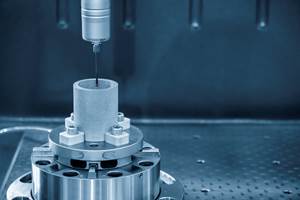Composites Keep A Big Machine Busy
On-machine inspection is part of the way this shop machines large composite structures efficiently.
Share





“The thing to understand about machining composites is that you only get one shot,” says Jeffrey LeDuc, general manager of Reno Machine Company in Newington, Connecticut. Unlike a metal part, there is little or no possibility of repairing a part made from a composite material such as CFRP (carbon fiber reinforced plastic) if it is machined incorrectly. Adding to the pressure is the fact that a CFRP structure is considerably more expensive than a comparable metal workpiece by the time the part gets to the machine tool. Any crash or misstep during machining would not only scrap the part, but also would result in considerable lost expense.
Partly because the size of its machines, Reno is in a class apart from other machine shops in its region. The shop has an established history of working closely with area manufacturers relying on large composite parts. Most of this work relates to helicopter manufacturing, and most of that work has involved machining metal to make both the layup tooling and the machining fixtures for composites manufacturing. Recently, however, customers have been turning to Reno for machining of the composite structures as well. Now, of the two five-axis Henri Liné machines with 35 feet of X-axis travel in this shop, one of those machines is booked for a solid year with just composites machining work.
Because of all the activity, a particular part on one of these machines is now likely to get just one shot in another way, as well. That is, all of the machining for a particular part may need to be performed in just one rapid stop at the machine tool, before the tight schedule requires the next part in line to get its turn.
However, many of these parts include demanding machining tolerances that may need to be verified multiple times. Because of the value of the part, a critical milled feature is likely to be machined conservatively, then inspected to see how much stock remains to be removed, then inspected again after the finish pass.
Reno does not have a CMM big enough to perform this inspection for its largest composite parts. Even if it did, the shop would not want to spend time on transporting the large parts to and from the busy Liné machine. Instead, Reno uses the machine tool itself as a CMM, thanks to an “On Machine Verification” version of Delcam’s PowerInspect software.
When this software is coupled to the five-axis machine as it employs a spindle-mounted inspection probe, Mr. LeDuc says the software can generate inspection reports that are every bit as thorough as those of a CMM. To confirm that the machine tool can indeed inspect parts accurately, smaller parts are often verified with a CMM. The inspection software makes the five-axis machine tool dramatically more effective for machining high-value, tight-tolerance parts, Mr. LeDuc says.
One particularly critical part provides an illustration of the close working relationship between the shop and its main composites machining customer. A CFRP cuff that connects a helicopter’s main rotor blade to the center hub is sent to Reno two different times for machining. The shop does initial machining of features including a bore that receives a metal bushing. The customer inserts this bushing. Then, the part goes back to Reno to machine features that have to locate with respect to the bushing’s position. In other words, on this part, there are actually two different moments when the shop gets just one shot.
Related Content
Marathon Precision’s Engineering Playground: One Shop’s Secret to Sustaining High Tech, Low-Volume and High Morale
Half an airplane on the wall, a ten-foot metal dragon, and a full-blown recording studio might not scream “manufacturing efficiency,” yet Marathon Precision proves otherwise. Here’s how forging, complex CNC operations and staff-driven creative projects combine to fuel the shop’s productivity and profitability.
Read MoreHow to Evaluate Measurement Uncertainty
Manufacturing and measurement are closely coupled. An important consideration for the use of measurement results is the associated measurement uncertainty. This article describes common metrology terms and provides an example uncertainty analysis.
Read MoreUsing Digital Tap Testing to Measure Machining Dynamics
Tool-toolholder-spindle-machine combinations each have a unique vibration response. We can measure the response by tap testing, but we can also model it.
Read MoreParts and Programs: Setup for Success
Tips for program and work setups that can simplify adjustments and troubleshooting.
Read MoreRead Next
AMRs Are Moving Into Manufacturing: 4 Considerations for Implementation
AMRs can provide a flexible, easy-to-use automation platform so long as manufacturers choose a suitable task and prepare their facilities.
Read MoreMachine Shop MBA
Making Chips and Modern Machine Shop are teaming up for a new podcast series called Machine Shop MBA—designed to help manufacturers measure their success against the industry’s best. Through the lens of the Top Shops benchmarking program, the series explores the KPIs that set high-performing shops apart, from machine utilization and first-pass yield to employee engagement and revenue per employee.
Read More






















